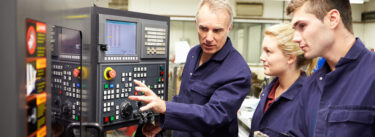It’s not unusual for a lean leader or lean practitioner to feel alone, especially in a company or enterprise early in its lean journey. Even if management is on board, for a sole person responsible for initiating kaizens and other lean activities, it can get awfully lonesome at times.
That’s exactly the way Brittany Garza felt, but she decided to do something about it. “I was feeling like a lone wolf here, because I’m the only one focused on lean at my company,” says Garza, Lean Specialist at Westech Engineering in Salt Lake City. An environmental engineer, Garza was hand-picked by her firm’s former quality manager to get the engineering and design firm’s lean effort going from scratch.
After a year or so into her assignment, Garza realized she needed some way to connect with others like herself who were deeply engaged in lean journeys in other organizations. She tried attending meetings of various groups such as AME, ASQ, and SME, “but I couldn’t find one that offered what I was looking for,” she says. “I wasn’t making any connections with people in the group. I wasn’t getting the mentoring and discussion I was looking for.”
Connecting via LEI
Then she registered on lean.org’s “Connection Center,” using the service to search for contacts in the Salt Lake City area. The Connection Center is a free service enabling members to contact other lean participants via messages on lean.org, using searches by sector, country, last name, and area of interest.
Garza followed up by sending emails to 20 people whose names she found through her search. She told them she wanted to connect with others in the region’s lean community. “I wanted to see what people were interested in and if they wanted to get together to meet and share ideas,” Garza says.
She quickly discovered that in the Salt Lake region, there were numerous lean specialists and lean leaders who were feeling exactly the same way – experiencing a strong desire to co-learn by forming a community of practice around lean. One of the people she connected with was Theresa Drulard, who works with the Manufacturing Extension Partnership at the University of Utah. “She helped me recruit some of the people in the group,” Garza says.
“We decided to call it the lean “pop-up” because it would pop up in different companies.” Thus, a different organization hosts the meeting each quarter. Some city planning departments have used “pop-up meetings” to engage members of the public by convening in different locations as a means to gather their input. There are pop-up dinners, pop-up prayer groups, pop-up yoga sessions, and even pop-up restaurants with temporary and shifting venues.
As is typical with pop-up events generally, each Lean Pop-Up tends to be unique based on the hosting organization and its experience on its lean journey. So far, the group has convened half a dozen times. “It’s been super beneficial for me personally,” Garza says. “You get energy from being around people who are so passionate about lean. It gives you the energy to keep going. They understand the issues you’re dealing with.”
For example, she says her company, which has about 380 employees, got ideas from another company that shared its approach to lean orientation for new hires. At the most recent lean pop-up in January, 30 people, including several Westech employees, learned from LEI faculty member and consultant Jean Cunningham, who conducted a training session on lean management.
Varying the format
It was the first pop-up where the group had decided to try a workshop format with an outside presenter. Earlier pop-ups typically were organized around a tour of the host firm, with a presentation by the hosting lean contact person, lunch, and then informal gatherings where participants explored various lean topics of interest.
Cunningham’s presentation was spiced with plenty of interesting Q&A participation as members shared their lean experiences while asking their workshop leader to share what she’d learned in her own. Among those attending were lean practitioners from FL Smidth, also an engineering firm; a 500-employee Caterpillar dealer; a division of Boeing Aircraft; and the local Church of Latter Day Saints (LDS Church) based in Salt Lake City.
Garza says the training session was the Pop-Up group’s first that had a real cost to it. LEI sponsored the session in half, while Pop-Up members who attended contributed the remainder. So far, the Pop-Up is self-funding, with members contributing to the group’s expenses.
Participants at the latest gathering included a number of Pop-Up regulars as well as some newcomers. Some appeared to be relative newbies to lean overall, but all were at least familiar with the concepts, goals, and terminology of Toyota Production System. “We have people from all different industries and work backgrounds in the group, not just manufacturing,” Garza says.
Those attending the recent Pop-Up said they planned to continue attending the quarterly Pop-Ups. They say they found the meeting format along with the shifting venue at a different company each time useful for both tapping a rich vein of new ideas, tips, and techniques among their peers as well as for establishing new contacts in the area’s lean community.
Pop-Up regular Kallen Konen, business and process support manager at the Minerals Testing & Research Center of FL Smidth, an engineering, design and manufacturing firm that competes with Westech, says she plans to keep coming to the quarterly lean gatherings because it helps her understand the many ways other companies apply lean ideas to their processes. “I enjoy the Pop-Ups because our company is not as advanced with lean,” she says. “For example, the tour of Boeing was so cool, being able to see how advanced their processes are. It was very beneficial to me.”
Admittedly, attendance at the quarterly Pop-Ups varies. Of the half a dozen Pop-Ups held prior to the most recent one, the participation ranged from a low of six at the second Pop-Up to a higher of 40 at the third gathering. The average Pop-Up tends to have about 20 people attending.
Starting a lean Pop-Up
Tapping into lean.org’s Connection Center wasn’t the only tack Garza took when trying to make contact with other lean leaders and practitioners in her region. “While attending a conference on operational excellence, I met some lean leaders from the Latter Day Saints (LDS) Church,” she says. Similarly, she met some lean people from other enterprises through contacts she made at a University of Utah Manufacturing Extension Program event. Finally, by networking with the first set of lean peers, she was able to develop still more contacts of other lean leaders at area companies.
Setting the venue
As befits a true grassroots initiative, Garza says the Lean Pop-Ups are held at companies that have volunteered to host. Typically that means the hosting company is open to providing a tour for up to 40 members, has a meeting space for the group, and is able to provide a box lunch with soft drinks. And, of course, a topic for the group to focus on.
Picking a topic
The group agrees in advance on a topic for each gathering. Typically these are issues or lean concepts that strike a common chord among all the members. Some topics of past Pop-Ups and upcoming ones are:
- A3s or one-point lessons regarding a lean success
- Where are you on your lean journey?
- 5S
- Visual Management
- Improvement project
- Cultural change
- Identifying cost savings opportunities
At one Pop-Up, members discussed what topics they were interested in pursuing at upcoming gatherings. Garza also sent out a survey to collect more feedback on which topics people wanted to explore. Then she emailed the group the list of topics, asking who would be interested in presenting and when they could host a Pop-Up.
“Typically we meet and discuss the provided topic for about an hour,” Garza says. The host company provides snacks as well as a presentation about the company and its lean journey. “After that we take a tour for about an hour to see what the company does and look at what lean tools they’ve implemented. We also stop and discuss what’s working well and what’s not working so well.”
Sustaining the Pop-Up
Okay, so you’ve got a Lean Pop-Up group started. The next big challenge is how to sustain it. In Garza’s case, her energy – combined with the passion she finds among the other members – provides the momentum needed to sustain the Salt Lake region’s Lean Pop-Up initiative. Especially in the face of organizational pushback that all lean leaders encounter, just having a sounding board of one’s peers “gives you the energy to keep going. They understand your pain,” she says.
Lean Pop-Up members agree. “It’s helpful to learn about how other companies started on their lean journey and the mistakes they made, and how they dealt with them,” says Taylor Ipsen, metrics/KPI champion and an operations analyst for Wheeler Cat, a Caterpillar equipment dealer in Salt Lake City. “You learn a lot being exposed to a change of culture and new ideas.” Adds Russ Holindrake, an operations analyst at Wheeler Cat, “It’s very useful to get the benefit of others’ experiences with lean. On the tour and presentation we had at Boeing, for example, their use of 5S was incredible. They had issues they were dealing with, and lean was the tool they used to fix their problems.”
Perry Osborn, a civil engineer at Westech who designs municipal drinking water equipment, echoes that thought. “It’s interesting to see how other people are applying different lean principles,” he says. Adds Bruce Lawrence, a financial controller at LDS Church, “I like the exposure the Pop-Ups give us, with different businesses and enterprises using lean.”
Mike Reader, purchasing manager in the LDS Church printing division, which publishes scriptures, teaching manuals, and textbooks, etc., says the Pop-Ups helped him understand how lean can be applied to improve non-manufacturing processes. “I wanted to see how lean was incorporated into an office environment,” he says.
Adds Garth Taylor, a lean facilitator at Boeing, “Coming to the Pop-Ups has been good for us. We always leave with something new. There’s a great benchmarking value. It enables us to see examples of how other companies and other industries are using lean. We plan to keep participating.”
What about attrition? How does the Pop-Up avoid being depleted of members when people change jobs, move away, or simply drop out? “We’ve had some people stop coming because they moved jobs or switched positions, so we are continually looking for new people to join,” Garza says. “But it hasn’t been a real issue to not have enough people involved. The only reason we need more people is to be able to share their knowledge and have more people involved to have an opportunity to share and learn.”
In fact, having the opportunity to share experiences and learn from others is at the core of what the Lean Pop-Up is all about. “This is a great example of an enthusiastic local grassroots effort,” says lean consultant and LEI faculty member Cunningham. “It’s a way for local people to get together in a safe environment to see each other and share ideas. It provides those attending a quick and easy sounding board. But it will sustain only if all the companies that are part of the Pop-Up evolve and have something new to share. And someone has to be the energetic leader who keeps it going.
In the case of the pioneering Salt Lake City group, that spark plug is Garza, who created the Lean Pop-Up simply because she was feeling alone in her role as the lean specialist in her company.





